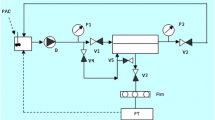Abstract
Purpose
The objective of this work was to identify deactivation agents and develop a disposal system for unused/ residual/ expired medications.
Methods
Deactivation agents screened included oxidizing agent-sodium percarbonate, hydrolysis agent- sodium carbonate and adsorbants- zeolite and activated carbon. Deactivation studies using these agents were performed on four active pharmaceutical agents (APIs) including ketoprofen, dexamethasone sodium phosphate, metformin hydrochloride and amoxicillin trihydrate. Disposal systems were also designed for deactivation studies on dexamethasone pills, amoxicillin trihydrate capsules and fentanyl transdermal patches (Duragesic®). Briefly, APIs/ dosage forms were allowed to be in close contact with deactivation agents for a specified period of time and percentage decrease in the amount of API from the initial amount was measured.
Results
Sodium percarbonate and sodium carbonate were only successful in deactivation of amoxicillin trihydrate API. Adsorption agents resulted in more universal deactivation with activated carbon resulting in efficient deactivation of most APIs and all dosage forms tested. Also adsorption of oral dosage medications on activated carbons was maintained even on dilution and shaking and no desorption was observed.
Conclusions
Deactivation systems containing activated carbon are promising for efficient, safe and environment friendly disposal of unused/residual/expired medications.






Similar content being viewed by others
Abbreviations
- API(s):
-
Active Pharmaceutical Ingredient(s)
- EPA:
-
Environmental Protection Agency
- EUR:
-
Molasses number specification
- FDA:
-
Food and Drug Administration
- GAC:
-
Granular Activated Carbon
- IUPAC:
-
International Union of Pure and Applied Chemistry
- ONDCP:
-
Office of National Drug Control Policy
REFERENCES
Available from: http://www.prweb.com/releases/2009/06/prweb2534454.html
Nieuwlaat R, Wilczynski N, Navarro T, Hobson N, Jeffery R, Keepanasseril A, et al. Interventions for enhancing medication adherence. Cochrane Database Syst Rev 2014, Issue 11. Art. No: CD000011.
Bates C, Laciak R, Southwick A, Bishoff J. Overprescription of postoperative narcotics: a look at postoperative pain medication delivery consumption and disposal in urological practice. J Urol. 2011;185(2):551–5.
Available from: http://www.dea.gov/pr/multimedia-library/publications/prescription_for_disaster_english.pdf
Available from: http://www.ncdoi.com/osfm/safekids/Documents/OMD/SafeDisposalOfUnusedControlledSubstancesReport.pdf
Available from: http://www.fda.gov/Drugs/ResourcesForYou/Consumers/BuyingUsingMedicineSafely/EnsuringSafeUseofMedicine/SafeDisposalofMedicines/ucm186188.html.
Snyder SA, Adham S, Redding AM, Cannon FS, DeCarolis J, Oppenheimer J, et al. Role of membranes and activated carbon in the removal of endocrine disruptors and pharmaceuticals. Desalination. 2007;202(1–3):156–81.
Nikolaou A, Meric S, Fatta D. Occurrence patterns of pharmaceuticals in water and wastewater environments. Anal Bioanal Chem. 2007;387(4):1225–34.
Available from: http://www.rsc.org/chemistryworld/2012/05/what-do-leftover-prescription-drugs
Andreozzi R, Canterino M, Marotta R, Paxeus N. Antibiotic removal from wastewaters: the ozonation of amoxicillin. J Hazard Mater. 2005;122(3):243–50.
Esplugasa S, Bilab DM, Krausec LGT, Dezotti M. Ozonation and advanced oxidation technologies to remove endocrine disrupting chemicals (EDCs) and pharmaceuticals and personal care products (PPCPs) in water effluents. J Hazard Mater. 2007;149(3):631–42.
Homem V, Santos L. Degradation and removal methods of antibiotics from aqueous matrices-a review. J Environ Manag. 2011;92(10):2304–47.
Widiastuti N, Wua H, Ang H, Zhang D. Removal of ammonium from greywater using natural zeolite. Desalination. 2011;277(1–3):15–23.
Yang J, Donga X, Zhoua Y, Yuea MB, Zhoua CF, Weia F, et al. Selective adsorption of zeolite towards nitrosamine in organic solution. Microporous Mesoporous Mater. 2009;120(3):381–8.
Goursot A, Vasilyev V, Arbuznikov A. Modeling of adsorption properties of zeolites: correlation with the structure. J Phys Chem B. 1997;101:6420–8.
Reed BE, Arunachalam A, Thomas B. Removal of lead and cadmium from aqueous waste streams using granular activated carbon (GAC) columns. Environ Prog. 1994;13(1):60–4.
Choi KJ, Kim SG, Kim SH. Removal of antibiotics by coagulation and granular activated carbon filtration. J Hazard Mater. 2008;151(1):38–43.
Park SJ, Jang YS. Pore structure and surface properties of chemically modified activated carbons for adsorption mechanism and rate of Cr (VI). J Colloid Interface Sci. 2002;249(2):458–63.
Dubinin MM. Fundamentals of the theory of adsorption in micropores of carbon adsorbents: characteristics of their adsorption properties and microporous structures. Pure Appl Chem. 1989;61(11):1841–3.
Dabrowski A, Podkoscielny P, Hubicki Z, Barczak M. Adsorption of phenolic compounds by activated carbon--a critical review. Chemosphere. 2005;58(8):1049–70.
Madan S, Madan P. Global encyclopaedia of environmental science, technology and management. 1st ed. New Delhi: Global Vision Publishing House; 2009.
Bauerlein PS, Mansell JE, Ter Laak TL, de Voogt P. Sorption behavior of charged and neutral polar organic compounds on solid phase extraction materials: which functional group governs sorption? Environ Sci Technol. 2012;46(2):954–61.
ACKNOWLEDGMENTS AND DISCLOSURES
This grant was funded by Travanti Pharma, Mendonta Heights, MN.
Author information
Authors and Affiliations
Corresponding author
Additional information
Anushree Herwadkar and Neha Singh contributed equally to this work.
Rights and permissions
About this article
Cite this article
Herwadkar, A., Singh, N., Anderson, C. et al. Development of Disposal Systems for Deactivation of Unused/Residual/Expired Medications. Pharm Res 33, 110–124 (2016). https://doi.org/10.1007/s11095-015-1768-1
Received:
Accepted:
Published:
Issue Date:
DOI: https://doi.org/10.1007/s11095-015-1768-1




